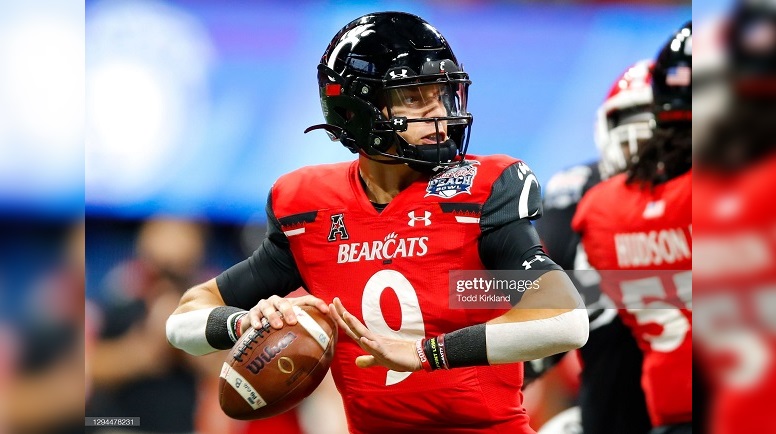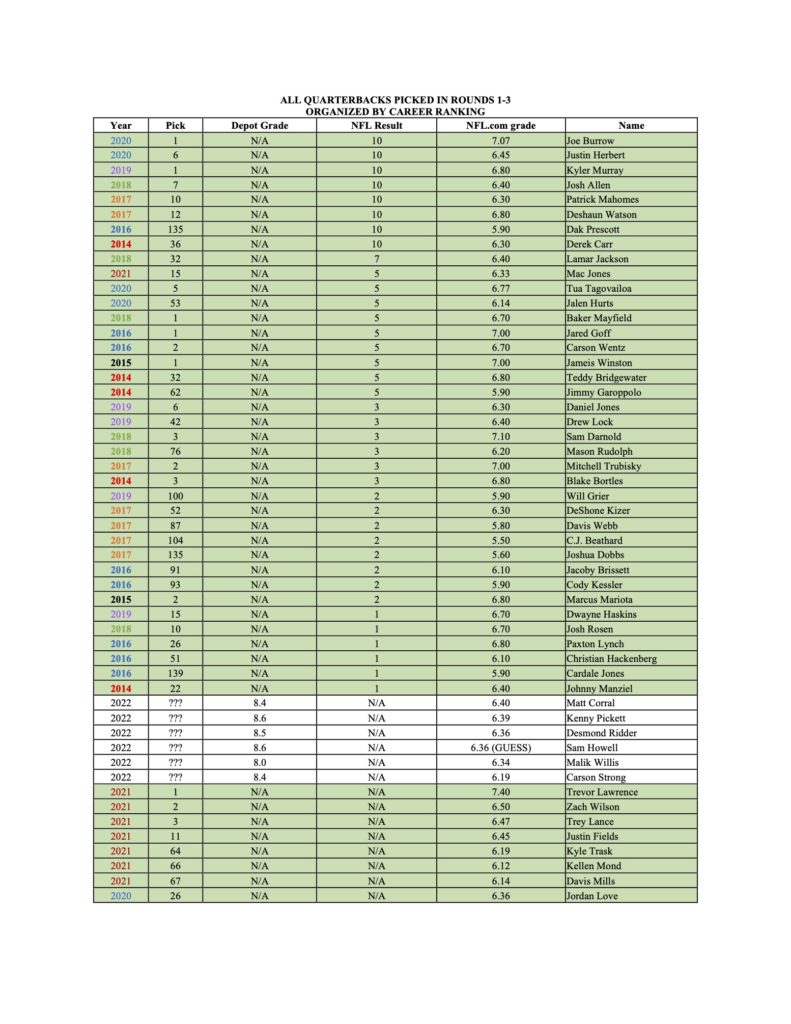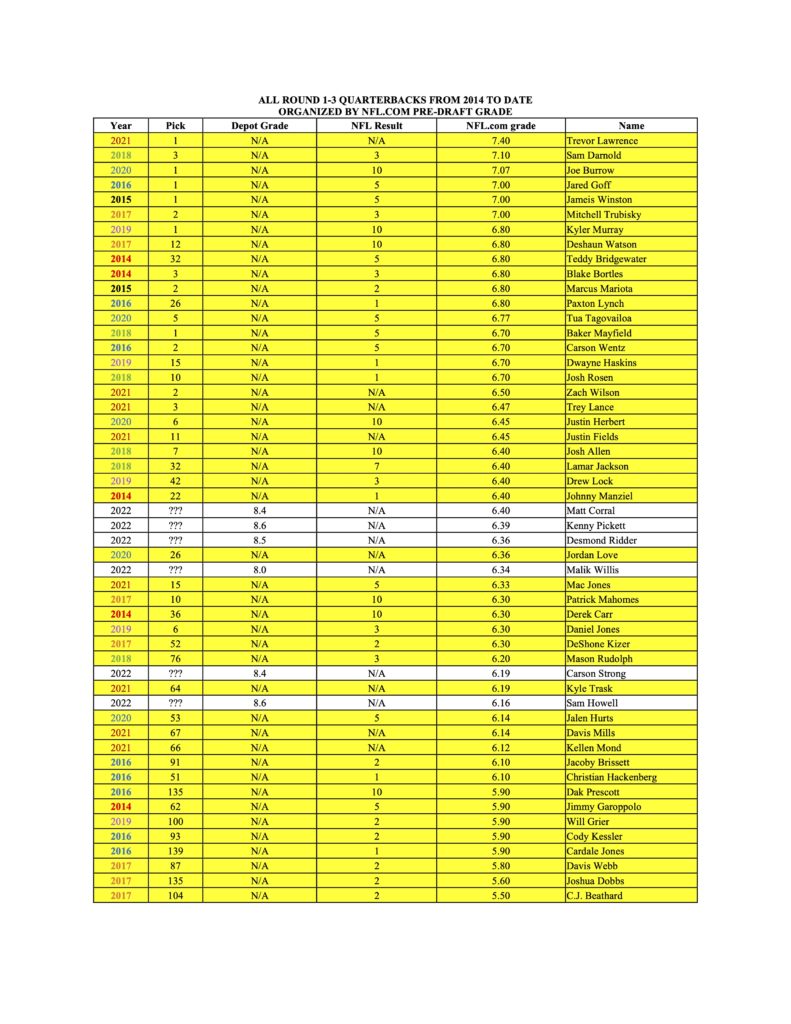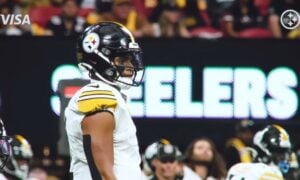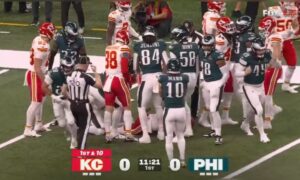Everyone knows – everyone! – that the Steelers are in the market for a true heir to Big Ben Roethlisberger. There are a lot of corollaries that everyone agrees with too. For all the fighting, we are all starting from much the same place.
- Quarterback is the most important position on the team.
- Quarterbacks come in basically four flavors: Franchise, Starter, Backup, and Bust, with gray lines between each category. Players often climb with experience, but can also drop as more responsibility is placed on their shoulders. Stats like “quarterback rating” and “completion percentage” can be altered by coaching plans that simplify the offense.
- Landing a franchise QB is the holy grail; starter-level QB’s are pricey but sometimes available; and backup QB’s are fairly easy to find.
- Translating to draft terms, franchise QB’s are worth multiple 1st-round picks; “mere” starters are worth a single Round 1 pick; and backups are Round 3-5 picks.
- Pittsburgh desperately wants a franchise QB, but can get by with a mere starter (a/k/a placeholder) while the team searches on. Such players have won the occasional Super Bowl, albeit with much narrower roads to success. Playing a backup as a starter would place a hard ceiling on how far the team can go.
- It would set the team back for years if the F.O. traded up for a franchise QB and instead got only a starter. Kevin Colbert recently went on record about his belief that trading up that far is almost always a bad idea.
- It would cripple the team for years to trade up in the 1st and end up with only a backup or a bust. Hence Mr. Colbert’s extra caution, one suspects.
- As a practical matter, you can only invest in a potential franchise QB once every 3-4 years or so.
The conclusion?
- The Steelers need to diligently search through every draft class from now until the Heir To Ben arrives, looking for that elusive franchise QB.
- If he’s there to be had, pull the trigger. That’s the “Dan Marino Lesson.”
- If he’s not there, stay as far away from that trigger as possible. That’s the “Leaf/JaMarcus/Manziel/Leinart/Rosen/Etc. Lesson.”
- It’s okay to invest in Rounds 2-7 picks at any time. All time great QB’s really do pop up from those ranks. It’s just very, very rare to the point of being almost pure luck.
There’s not a single line in any of the above that thinking fan will challenge. The question is, should Pittsburgh pull that oh-so-risky trigger on one of this year’s crop of QB prospects? Or should the F.O. put its allowance money back in the bank, build the team, and wait to review next year’s models?
SHOULD THE 1:20 PICK BE SPENT ON A PLACEHOLDER?
I wrote up above that “mere starters” are worth a Round 1 pick. This presents a pair of questions. First, does the team have a placeholder-level QB on the current roster? And second, does the draft contain any prospects who project as quality starters? One needs to remember that lots of drafts do not.
Opinions differ on whether Mason Rudolph can serve as an interim placeholder, with Kevin Colbert apparently on the positive side. We can argue about it endlessly, but the bottom line is that no one will know unless and until he gets that chance.
The other in-house option is Dwayne Haskins, Washington’s big armed 2019 first rounder (#15 overall) who busted so completely due to a combination of immaturity and failure to read NFL defenses. Everyone got excited when he came to Pittsburgh in 2021, because Haskins definitely has franchise potential; no one deals with immaturity better than Mike Tomlin; and most people agreed that Haskins got thrown into the fire too quickly. Maybe a year or two of serious film work and education would teach him the ropes? Again, we have no way of knowing where Dwayne Haskins currently falls on the scale of QB’s. We’d have heard something if he’d bombed. We’d have heard if he suddenly blossomed. But we would not have heard if he was slowly failing or still beginning to blossom. We haven’t heard diddly except for Kevin Colbert’s recent statement that Haskins is still in the mix. Time will tell.
If you believe that a placeholder is required in addition to a franchise QB, look at Kenny Pickett in this year’s class. He is the generally acknowledged “high floor” pick who’d be going in the Top 5-10 if his ceiling was similarly high. Carson Strong would be a Round 2 option. His issues are lack of mobility and a long history of knee problems.
All the other prospects (see below) have franchise-QB potential, offset by serious flaws.
AGGREGATING THE DRAFT PROSPECTS
You may not know it, but I drive a lot of serious draftniks somewhat crazy because my work focuses on gathering a consensus opinion rather than watching film to develop a view of my own. I’m an aggregator and organizer of data, not a direct content producer like your local paper.
So I am not going to give you new content here with evaluations of this year’s prospects. Instead I’m going to put those prospects into a multiyear context. Where would XYZ prospect from this year rank if he was in the 2021 draft? Or 2020? Or any other year going back to 2014? The goal is to determine what level of investment makes sense in light of historical results.
MY METRICS
The NFL.com grade. This study goes back to 2014 because that is the earliest year when NFL.com started publishing Lance Zierlein’s prospect grades. I do not mean to imply that Zierlein is the be-all and end-all of evaluators! Don’t take that wrong. But neither is he a bad one. To quote Alex Kozora, who I discussed this with, “Zierlein is a solid evaluator and probably the best guy to use for something like this since he’s been at it a long-time and has some NFL ties with his dad.” Best of all, Zierlein grades every QB neutrally against his personal scale on a year by year basis. He doesn’t limit his grades to a board that only compares players within a single year.
The Steelers Depot grade. As of 2022 the Depot scouting reports strive to give a neutral grade comparable to what Lance Zierlein has been doing. When we do this article five years from now, that will be the #1 source since our evaluators are obviously better than he is. Right?
Pick Number. At some level this reflects the general NFL consensus on a QB’s value. I consider it less reliable than the first two because of how often we’ve seen wishful thinking distort what the professionals do on lesser teams. That is the thing we’re hoping to have Pittsburgh avoid; overpicking a prospect because having a fantasy of QB success feels better than quietly and professionally waiting until a real chance of QB success rolls around.
The Pavelle “NFL Results” Grade. Can anyone predict QB success in advance? Maybe not, but it’s easier to do with hindsight. This is my effort to quantify career results. Feel free to disagree with the grade and to assign your own. The odd numbering is there to show how big a difference there is between average, good, and great at this position. I used the published 2021 QB rankings to divide the tough cases. All of the “solid starters” graded out between this year’s Top 16-25 on that list, so separating them was just too arbitrary..
- 10 = Franchise QB (Top 10)
- 7 = Good Starter QB (Top 15)
- 5 = Solid Starter (Top 25)
- 3 = Gray area between weak starter and good backup
- 2 = Backup QB
- 1 = Failed
Here are four tables organized by those metrics. First comes the table by my NFL grade, because the results stunned me a bit. (NOTE: The numbers don’t add up because this table does not include superior veterans).
Lesson #1: For heaven’s sake, don’t reach! There have been only eight quarterbacks picked in the past eight years who graded out as franchise QB’s, and several of those are younger players may drop in the rankings as they gradually take on extra duties in their offense. See what happened with Carson Wentz, Jared Goff, Baker Mayfield, and Daniel Jones. Anyway, the bottom line is that franchise QB’s seem to appear at a rate of no more than one per year, and many years produce none. So those big trades are very risky indeed. Don’t reach for a QB unless you are very, very sure indeed.
Lesson #2: A solid 75% of franchise QB’s come in Round 1. Dak Prescott was picked in Round 4, and Derek Carr in Round 2. I can remember those drafts, and will testify that Prescott fell because of two reasons: (a) his final year of play was distorted by an unbelievably awful O-Line, and (b) character concerns arose right before the draft that overshadowed his play on the field. Without those he would have deserved a Round 2 ranking as well, even in that very strong year. Derek Carr was similarly pushed down, except this time by the memory of his brother David’s failure to thrive.
For what it’s worth, both Sam Howell and Malik Willis struggled behind terrible offensive lines in 2021, and had limited weaponry to bail them out. We ought to pay attention to studies that focus on how much that impacted their play.
Lesson #3: Make that 80% for good QB’s. There are ten players with a grade of solid to good. Eight of those were picked in Round 1. The other two, Jimmy Garoppolo and Jalen Hurts, were both picked in Round 2.
Lesson #4: Contrary to popular belief, there is a pattern to many good looking prospects that fail. I’m going to stereotype here a bit based on what’s been reported rather than what’s actually known. My apologies to anyone I’m slandering on the basis of too little research. That said, there should be enough truth in this to carry the point:
- Josh Rosen – could not create off schedule, and could not read NFL defenses well enough to overcome that deficit.
- Dwayne Haskins – could not create off schedule, and could not read NFL defenses well enough to overcome that deficit.
- Paxton Lynch – could not create off schedule, and could not read NFL defenses well enough to overcome that deficit.
- Johnny Manziel – drank.
- Christian Hackenberg – could not create off schedule, and could not read NFL defenses well enough to overcome that deficit.
- Cardale Jones – could not create off schedule, and could not read NFL defenses well enough to overcome that deficit.
That is all the prospects who grade out as total failures. The pattern? If you play like a Tom Brady wannabe, you better be a friggin’ genius at reading NFL defenses. Otherwise your odds are much, much worse than people think. Mobility doesn’t make a young QB, but my results suggests that it may well save him while he spends the half-decade or so required to really learn his craft. It’s a good way to divide the failures from the also-rans. But it doesn’t come close to guaranteeing success.
Lesson #5: Film watchers are good at predicting acceptable players. The lower your draft pick and the lower your evaluator grade, the lower your chance is to ultimately succeed. Enough exceptions apply to suggest that NFL really is a meritocracy, but the pattern is strong enough to confirm that what you see in college has a strong correlation to what you’re likely to see in the pros.
Next table up: Organized by Lance Zierlein’s pre-draft grades.
Lesson #1: Zierlein and the teams tend to agree. Zierlein’s highest grades tend to coincide with higher draft picks, and lower with lower. There is an obvious correlation. He grades in much the same way they do, subject to personal preference.
NOTE: I can confirm this for both Daniel Jeremiah and Mike Mayock as well. Their personal big boards tend(ed) to correlate pretty well with draft order in any given year. Call it plus or minus 20 picks. I don’t have access to information that would let me do the same study on ESPN’s experts. Those tables are NOT included in this article because they do not have neutral numbers that allow for comparison across years as well as within the single year when they were produced.
If this correlation holds for 2022, we can expect both Carson Strong and Sam Howell to be available in Round 2, and maybe in Round 3 as well. See the “Bonus” at the end of this article for my thoughts.
Lesson #2: Zierlein has his misses both high and low. He, liked most people, graded a lot of the future busts very high. He may wish to adjust the grading scale to discount players that lack good mobility (not to raise those who have it, just to lower those that don’t). As for the success stories that hindsight says he graded too low:
- Mac Jones – The jury is still out. His grade is supported by having a limited role compared to more veteran QB’s.
- Patrick Mahomes – The boom or bust prospect who boomed. Andy Reid may be the main difference between grade and result.
- Derek Carr – Too big a discount because of his brother? It also took him so long to “arrive” that it may have been a fair grade after all.
- Jalen Hurts – Same as Mac Jones. He is still being protected by his coaches.
- Dak Prescott – Everyone gave that stupid scandal too much weight. Also, what would have happened if his NFL O-Line had been as bad as his college one? Again, c.f. Sam Howell and maybe Malik Willis.
- Jimmy Garoppolo – Hard to call this a miss. His grade is teetering a bit, and he lucked into a perfect situation(s) just like Patrick Mahomes did.
That’s a better record for Zierlein than the numbers suggest. The success stories seem to be more about where the prospect landed than about the prospect himself.
Lesson #3: All of this year’s prospects look like trailers, not engines. Zierlein has not come out and put a doubt-stamp on any of this year’s Big Six under the gun, with the possible exception of his significantly lower grade on Carson Strong. But he seems to be grading all of them in what usually equates to the late-1st or early-2nd range. More important, they are all grouped in with prospects from earlier years that either (a) had a very rough go, or (b) landed in a good situation where they did not have to carry the team on their shoulders.
As to “A”, I expected worse to be perfectly honest. My personal grades have been in that early-2nd range, with little fringe about it. So I stand corrected to that extent. Still reaches for 1:20, but not awful reaches. Definitely not worth trading up for… but that is another debate.
“B” may be the more important factor. The success stories in this range all involve players who fell into ideal situations. Josh Allen is a perfect match to Buffalo’s staff; the Ravens remade their entire offense to suit Lamar Jackson; Patrick Mahomes lucked into Andy Reid; Mac Jones lucked into Bill Belichick; etc. Daniel Jones started out looking good, and then fell apart… along with the coaching situation. Coincidence? Derek Carr was a career long journeyman until Chucky arrived as his new head coach. Etc. It’s a pretty strong pattern.
What would be the situation in Pittsburgh? I will leave it to you guys to unload the normal amounts of wildly extreme Tomlin-hate, along with its leavening of he-can-do-no-wrong adoration. I cordially dislike both extremes, thank you very much. What I worry about is the sorry state of the offense as a whole. The 2022 Steelers will not be a good spot for QB’s that need to jump on to an already running train. The defense should be top notch, but the offense is going to struggle for at least another year or two.
I will therefore side with those who’d prefer early investment into a premiere offensive lineman or two. None of this year’s prospects look like the sort of player who could lift the team up while that struggle moves forward. Better to pick their like in some future year when the new QB will be able to rely on his teammates instead of it being the other way around. If someone falls to Round 2, great. If not, then wait.
BONUS THOUGHTS
That comp between Sam Howell and Dak Prescott popped up purely as a result of the comparisons in this article, but once it occurred I couldn’t get it out of my head. So I reached out to both Jonathan Heitritter, who wrote the Depot scouting profile, and to Alex Kozora. “Do you remember when Dak Prescott came out, and got downgraded for his supposed ‘regression’ in the final year? Does the comp to Sam Howell have legs?”
Both agreed that it does. Jonathan wrote:
“Yes, I remember Prescott as a prospect quite well and feel that Howell is getting beat on for his most recent production rather than acknowledging how successful he was his first two seasons on campus with a better supporting cast around him. The offensive line was bad, the running game was hit-and-miss depending on the week, and outside of Josh Downs, he didn’t really have a consistent threat in the receiving game.
“I think the comp has legs for sure and see Howell in that Prescott/Mayfield/Carr tier where he may not be a All-Pro player, but he has all the tangibles as a passer with the mobility to warrant being a quality starter (Top 10-15) type of player at the position in the league as long as he isn’t forced to make chicken salad out of chicken [ahem] if you know what I mean.”
Alex’s comment was:
“As for the Dak/Howell, yeah, I think that’s solid in that respect. I don’t know how much they compare beyond that. Probably to a degree. QBs who are mobile, good arms, played at a higher-end school. Dak seems a little more outwardly vocal than Howell. Howell seems super reserved. But I like the comp there.”
I’m not saying that makes Sam Howell a favorite for the pick at 1:20. Far from it, though I will keep my mind open. But if he falls to the Steelers in Round 2? Which should be entirely possible if we give credence to the idea that Lance Zierlein tends to grade QB’s in much the same way as the teams? I’m there. History suggests that he might be exactly the right kind of bargain to look for.

